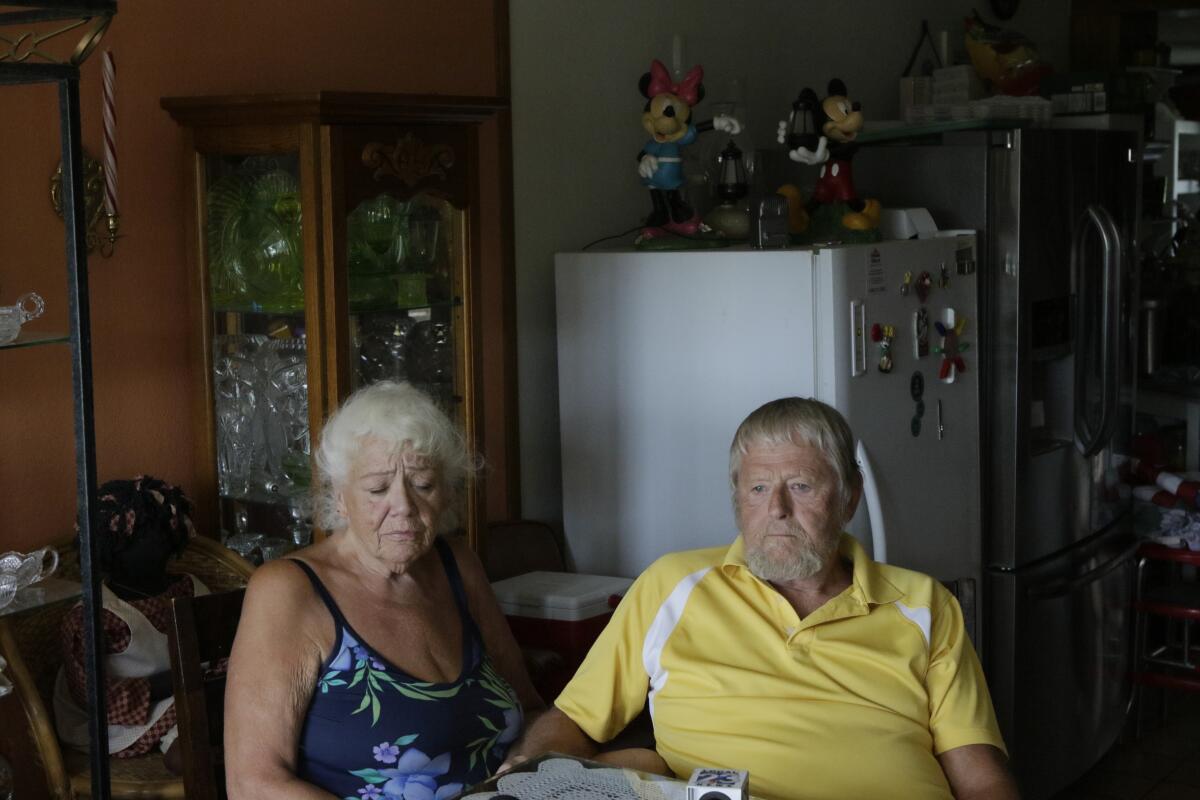To reach Mars, SpaceX is trying to buy up a tiny Texas community
When SpaceX chose a tiny waterfront community at the southern tip of Texas in 2014 to house its newest facility, it said the consequences for residents would be manageable.
Public access in and around Boca Chica Village would be restricted on 12 launch days per year. Once a year, a night launch would illuminate homes and cause “significant” noise impacts. Those effects would be outweighed by the “hundreds of high-tech jobs,” business benefits and tourists that would come to the Texas site, SpaceX Chief Executive Elon Musk said in 2014.
But SpaceX’s plans have changed — and so too could the future of Boca Chica.
With the Texas facility now central to the company’s ambitions to land humans on Mars, the Hawthorne firm aims to expand its footprint in south Texas. That means buying out local residents.
For SpaceX, the expansion provides a secluded testing ground for its new Mars spaceship, as well as a private launch site where the company can work on its own terms and schedule. For residents, it’s a difficult bargain: a payout in exchange for giving up a life of peace and seclusion near the shores of the Gulf of Mexico.
“I really thought I would be able to stay until my last days,” said resident Maria Pointer, who lives close to the SpaceX facility and received a buyout offer.
Boca Chica Village is an unincorporated community about 20 miles from the city of Brownsville. Satellite imagery shows there are about 35 houses in the area.
Water is trucked into the community once a month, and visits to a laundromat in Brownsville take about 30 minutes each way. Residents have bay views from their homes.
In a buyout letter dated Sept. 12 and delivered to residents via FedEx, SpaceX said “it has become clear that expansion of spaceflight activities as well as compliance with Federal Aviation Administration and other public safety regulations will make it increasingly more challenging to minimize disruption to residents of the Village.”
Musk said as much Saturday during an unveiling of SpaceX’s Starship Mars spaceship prototype, telling the assembled crowd that SpaceX was working with the residents of Boca Chica Village because “over time, it’s going to be quite disruptive to living in Boca Chica Village because it will end up needing to get cleared for safety a lot of times.”
“I think the actual danger to Boca Chica Village is low, but it’s not tiny. We want super tiny risk,” Musk said. “Probably over time, better to buy out the villagers. And we’ve made an offer to that respect.”
When SpaceX first identified Cameron County, Texas, as a potential location for a spaceport, the company planned to use the site to launch its Falcon 9 and Falcon Heavy rockets.
But by 2019, planned operations at the site changed to include short “hops” of the Starship prototype and other tests, according to a May reevaluation of a 2014 environmental impact statement. The FAA concluded that noise from the Starship operations would have no “significant” impact on Boca Chica Village.
However, the new analysis was limited to those smaller hop tests — the latest of which occurred in August. The report does not cover more advanced tests planned for Boca Chica in which the prototype would be launched to 320,000 feet before returning to the ground.
The Starship is central to SpaceX’s future. The company plans to eventually use it to replace its workhorse Falcon 9 rocket and its newer Falcon Heavy rocket. Its duties could one day include routine satellite launches, carrying billionaires on tourist trips around the moon, and ferrying up to 100 humans at a time to colonize Mars.
On Saturday, Musk unveiled a larger prototype of the Starship Mars spaceship, telling an audience in Boca Chica that the craft could test launch to about 60,000 feet in the coming months, with possible orbital launches in less than six months.
The first crewed launches of Starship, he said, could take off from Boca Chica.
“They see this area as a potentially lucrative launch site for some or most of the work they’re intending to do,” said Marco Caceres, senior space analyst at market research firm Teal Group. “Any company that has such expansive plans is going to need as many launch sites as possible.”
SpaceX has been buying additional land in the area since establishing the south Texas facility, said Nick Serafy, Jr., chairman of the Cameron County Space Port Development Corp., which manages the state incentive funds directed toward SpaceX.
Dogleg Park, a subsidiary of SpaceX, currently owns 112 parcels of land in Cameron County, most of which are in the Boca Chica area. The entity owns at least six homes purchased from 2014 to 2017. The assessed values of the homes ranged from $24,000 to $149,000, and the estimated sale price for one was as high as $303,000, according to TLOxp, a database that includes real estate assessments and sale prices.
“It’s not uncommon for them to be buying property,” Serafy said of SpaceX’s September buyout offer.
In the buyout letter, first reported by Business Insider, SpaceX said it was offering homeowners in and around Boca Chica Village three times the appraised fair market value of their property. SpaceX’s current offer price is “not negotiable,” the company said in the letter, adding that it was “very important to offer the same deal to all residents” and that the “fairest approach” was to use a consistent method for determining the amount offered.
The offer was good for two weeks and ended last Thursday, though SpaceX said in its letter that it understood the proposed timeline “may be challenging.”
The company said that it was “committed to retaining maximum flexibility” and that it would allow residents “rent-free access for an agreeable period” to give them time to make necessary arrangements.
But some residents expect negotiations to continue despite the stated deadline.
SpaceX cannot compel residents to sell their property. But legal experts say the company could go to county officials and ask them to make the properties subject to eminent domain. And the Cameron County Space Port Development Corp. has the authority to declare eminent domain, though Serafy said SpaceX has never discussed using this power.
It would be “politically risky” for a public authority in Texas to declare eminent domain on residents’ property, said Andrew Morriss, dean of the school of innovation at Texas A&M University, who co-led a research project on eminent domain law in 50 states.
“Texans take property rights seriously,” he said.
That can, at times, clash with the state’s reputation for business-friendly policies.
“It’s something that the state itself is wrestling with,” said Ryan James, associate professor of urban and regional planning at the University of Texas at San Antonio.
SpaceX has not told the county what it plans to do with the additional land it is seeking, said Cameron County Judge Eddie Treviño, Jr., who serves as a de facto spokesman for the county on some issues.
“It’s a tough situation,” he said. “I certainly understand the homeowners’ frustration with the current and recent development, but when you’ve got the possibility of a new space industry being developed in your region, one that is sorely lacking in good-paying, technological, modern-type jobs, I think as county judge, I have to look at the big picture.”
“Unfortunately,” he said, “sometimes progress comes at a cost.”
SpaceX already has launch sites at Vandenberg Air Force Base near Lompoc, Calif., and at Florida’s Kennedy Space Center and Cape Canaveral Air Force Station. But SpaceX shares those facilities with other companies, such as United Launch Alliance, and must work around other scheduled launches and tests.
At Boca Chica, SpaceX could call the shots and control its test and launch schedule, said Ramon Lugo, director of the University of Central Florida’s Florida Space Institute and former deputy program manager of Kennedy Space Center’s launch services program.
But Boca Chica, unlike the California or Florida launch sites, also has homes close by.
The 2014 environmental impact statement released by the FAA said the closest house to the launchpad was about 1.8 miles away; during space shuttle launches, NASA made sure that everyone — except a specially outfitted crew rescue team — was outside a three-mile radius to ensure public safety. However, that safety radius can vary depending on the rocket, Lugo said.
“I think [Musk] is doing it purely to avoid problems down the road,” he said of the buyout offer.
SpaceX declined to comment on questions about the buyouts, as did Chicago-based commercial real estate firm JLL, which is managing the buyout process.
Recently, residents have had firsthand views of SpaceX’s development, especially in the last few months. Pointer has gained an online following for her on-the-ground photos and videos of the Starship development, mostly shot from her property. A Facebook page where she posts her images has more than 7,000 likes.
Other residents and local space enthusiasts have taken to Twitter to post updates on work being done on the spaceship.
At times, photographers and livestreamers have captured hiccups in the development process that might not normally be seen. In July, enthusiast livestreams of a Starhopper static fire test showed a fireball engulfing the side of the prototype. And videos captured an unexpected brush fire that occurred near the launchpad after a hop test that same month.
Some homeowners in Boca Chica have said they do not plan to accept SpaceX’s offer.

Boca Chica Village resident Terry Heaton told the Brownsville Herald last week that SpaceX’s offer is too low for him and his wife to consider selling, saying, “it’s just big money bullying little people.”
Pointer balked at the appraisal of her property cited by SpaceX, saying it didn’t account for specific attributes of her home, such as the scenic views from her windows and its size. She said she and her husband spent years building out their home by digging out a driveway, planting papaya and lime trees and growing a garden.
She plans to get her own appraisal and bring it to the table to continue the negotiations.
If the company made an offer she and her husband deemed fair, Pointer said, they would take it. The couple aren’t sure where they would move, though they have family and “places to spend time to visit and to contemplate that location.”
“I don’t see any other choice,” she said. “Whatever way it falls, you have to make lemonade out of lemons.”
Times researcher Scott Wilson contributed to this report.







